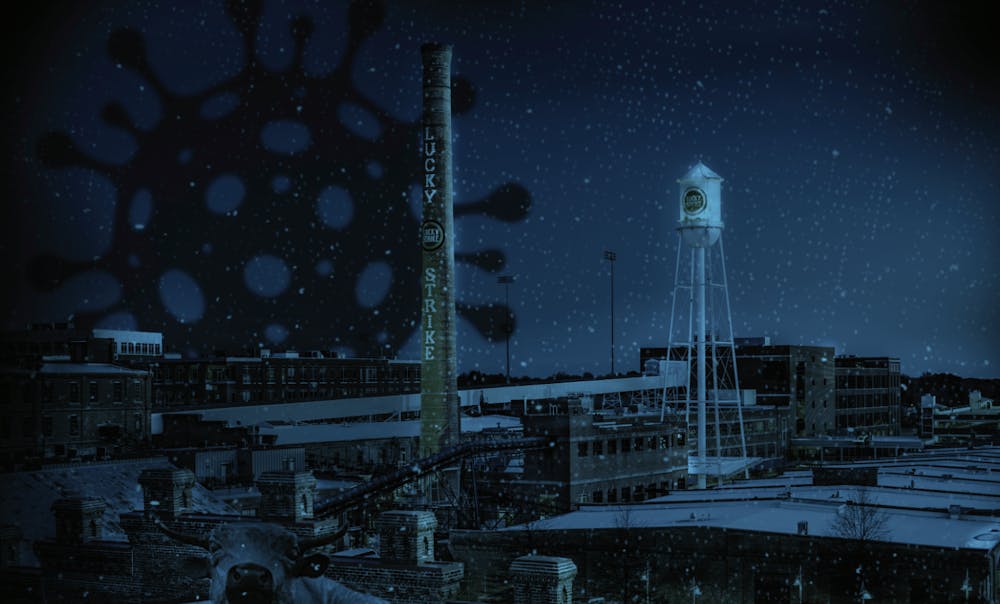Celebrating its 10-year anniversary at its location on Main Street, the Museum of Durham History (MoDH) has opened a new exhibit focusing on some famous Durhamites and the stories of everyday children and teachers.
Upon exiting the brick building section of main street that used to be the home of Durham Tobacco, MoDH shifts the visitor’s focus from the economic and physical history of Durham to the people that have shaped it. One is greeted by a row of banners entitled “Faces of Durham,” that includes figures ranging from Benjamin Newton Duke to William Gaston Pearson to Brenda Armstrong. The banners try to strike a balance between acknowledging those who provided the sometimes ugly foundations for the community of Durham, while telling the lesser-told stories of those who have strengthened and reshaped those same foundations.
The banners lead directly into the newest exhibit, “Stranger Times,” a series of hanging banners that line the outside of a welcoming gazebo. The exhibit explores the childhood story of the Duffer Brothers (the creators of Netflix’s “Stranger Things”) in Durham, their career and the challenge of education in Durham during the pandemic – explored through the language of the show. Accompanying the brothers’ journey into filmmaking as mild social outcasts are descriptions of the show itself and its characters (most of which sharing the same social standing as the creators themselves). While the new exhibit takes up the majority of the gazebo, a portion is left to tell the story of the integration of high schools in 1963 and the continued tensions between race, class, and education. This provides a stark contrast to the lightheartedness of this portion of the “Stranger Times” exhibit – a statement about what the museum believes will drive engagement versus the stories that still need to be told.
The new exhibit continues into the physical walls of the museum, now transitioning to COVID-19’s effect on education in the Durham community. The exhibit chooses to use the metaphor of the Upside Down (a torment-filled parallel universe to our own in “Stranger Things”) to elucidate the dramatic shift to online learning for students of all ages. It includes video interviews with Durham public officials, teachers and students – treating the pandemic as a collection of personal stories, not as a sociological or public health phenomenon. In one of the more poignant sections in “Stranger Times,” the curator includes their own child’s struggles with mental health during lockdown. It’s this sincerity that gives MoDH its charm.
Talking with the museum’s operations manager, it’s easy to see the passion for both the museum and the city of Durham that those involved have. However, practical barriers appear to limit the effect that this care can have.
While discussing the process for creating the new exhibit, which is very modern compared to past exhibits, he said, “Stranger Times,’ is quite the departure from our usual agenda. Our curator wanted to do something that captured the attention of a younger audience. The overall themes of the exhibit are contemporary history with a lot of nostalgic themes, and we certainly emphasize mental health.”
Dealing with space constraints and a community with more stories to tell than voices to tell them, MoDH has tried to adapt: “Since the pandemic, we have had at least five outdoor exhibits. We are certainly exploring other ways to utilize our space in unique ways on site; however, in the past year, we have definitely increased the scope of our online exhibits.”
One of the other exhibits, “Look Beyond the Windows,” asks the visitor to look up from the exhibit itself, into the city of Durham and at historic locations such as the Hill Building, Hayti Neighborhood, and the N.C. Mutual building. While the latter still stands proudly, the former two locations have been covered up by an outcrop of apartment complexes and parking ramps. Functioning as an on-the-nose metaphor for the struggle of continually canonizing an ever-changing community, these outcrops of growth are both a promise of a bright future and a warning to not lose the past.
Get The Chronicle straight to your inbox
Sign up for our weekly newsletter. Cancel at any time.
Kadin Purath is a Trinity junior and a culture editor for Recess.

